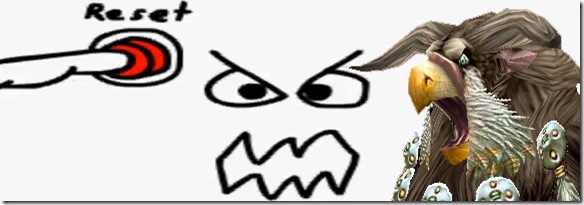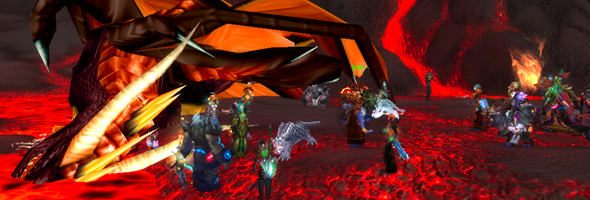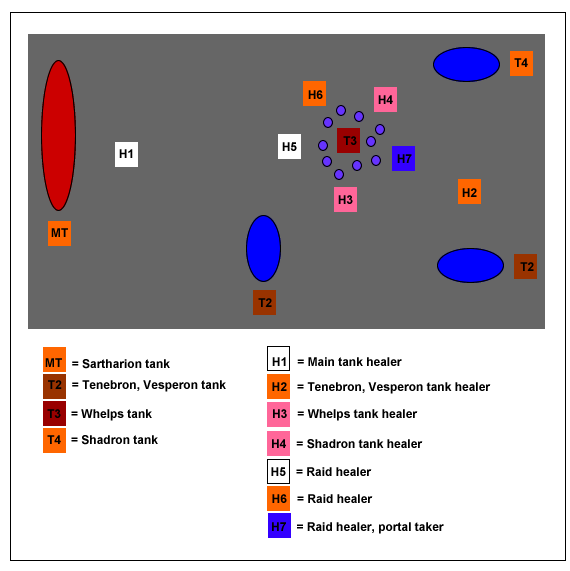Every week I watch different players doing things in Onyxia encounters that could make healers spit flame. Not only that, I find myself reacting to and making the same mistakes every week. So what are these recurring things, and how can everyone make sure that healers don’t turn into fire breathing dragons?
Traditionally us healers don’t do much slaying of anything, especially dragons. We do something much more important. We’re the brave souls who sally forth calmly into the face of death to keep others in one piece, or at least standing vaguely upright. You know those others – the heroes who charge in bandying about a cacophony of curses. The ones who would get flamed into foil-packed toasted sandwiches or seared to a fowl-shaped frieze on the wall, or reduced to roasted bear.
But other heroes like to keep us healers on our toes. Hell, we like to keep ourselves on our toes. A dragon slaying party can make a lot of mistakes, and you’d be surprised how few heroes seem to know the Basics of Dragon Slaying. Many bands of adventurers charge into the dragon’s den without checking that everyone knows those basics, which I think is mistake #1.
So what are the most common and basic mistakes a do-gooder can commit while trying to saw Onyxia’s head off? And what can us healers, whatever class, do so we don’t feel like taking a deep breath and belching fire at people? Well, a long career of healing dragon slayers has taught me a lot.
Here are my top ten observations for both us healers and your actual slayer of dragons to remember while venturing into Onyxia’s den, especially if braving the fight with a motley crew of unknown quantities.
I always see tanks or DPS…
1. Getting cleaved. Obviously this is a hazard of the job for tanks. But every time I go to Onyxia there are some foolhardy melee DPSers who like to stand face to face with their foe. I always find myself politely telling them that if they stand behind the trash they will do more DPS and won’t die from cleave, which is something most monsters in the den do. This is always after at least two DPSers die once or one of them dies twice
2. Going out of Line of Sight. There is a hill on the path to Onyxia’s den. And just over that hill is – well, is your tank. And he’s found himself facing an angry dragonkin whom he can’t move for fear of cleaving the party apart. Positioned just right so that if you stay safely at range you’re over the hill and far away for healing purposes, but if you go in close you’re in danger of getting cleaved (see above)
3. Killing people by big-add AoE proxy. I’ve seen tanks pick up big adds on phase 2 and move to tank them next to healers and ranged folk. I sometimes don’t see this until the add’s AoE has fried me because I am looking at healing addons and frantically trying to keep everyone standing upright rather than watching the pretty pictures on the screen. Likewise, melee folks should run away from this AoE, but don’t always do so.
4. Panic-position Onyxia. This happens when she lands in phase 3. Things are hectic and every tank has a different idea where’s best to position a large angry dragon.
- The tank might place her at the back of the cave: if he does then players are likely to get feared into a tail swipe and bring out many whelps. Handle it.
- The tank might instead place her at the side of the cave: if he does that then players will get feared and tail swiped but probably not into the whelp eggs.
5. NOT dealing with whelps. Whelps are hungry when they wake up and there are a lot of them. If they’re not controlled and killed then they will quickly attach to a healer and start munching, or gobble up the mage they noticed AoEing at them. Hell, I’ve often seen tanks bashing away at a clutch of whelps all on their lonesome on phase 1, with no DPS bothering to go to them – unless you count those flying past into the whelp eggs and skulking back out again, leaving the tank to deal with more.
Tips for healers …
1. Watch where you stand. Particularly during phase 2. Make sure you’re not too close to the southern area where the big adds spawn, especially if the tank on big adds is a bit sleepy. Said big add may appear, set eyes on you and think you’re the tastiest target. It’s also easy to get out of range of people, especially ranged folk who are doggedly following Onyxia up and down the cave. Avoid all this by trying to strafe across the middle of the cave in p2.
2. Be on your toes during deep breath. Get out of the way of it, of course. Start heading back into the middle of the room as soon as it’s passed in order to beat fires out on anyone who didn’t manage to get out the way in time.
3. Never assume the tank is in safe hands. Healers get themselves tail swiped and cleaved too – I’ve seen it. Heck, even phase 2 is dangerous – deep breaths may mean that the tank and healers are separated. Last week I was in a run in which all the healers dove to one side of the room during deep breath and the tank went the other way – we all assumed one of the other healers would stay near him. Panic mode ensued. Try to stay in range of the tanks at all times but not too close. That way fried healers lie.
4. Run diagonally. Sounds weird, but look at the shape of the cave – very long, and the monsters tend to spawn or be tanked at diamond points. The tank’s making the pull? If you run in a strange line – and next to the tank – you’ll get cleaved or tail swiped right away. I saw a priest do just that last week. Run diagonally in and you’ll always be in range to top off the tank as he’s moving Onyxia and you’ll end up standing in a safe place. Likewise throughout the fight, diagonal lines will often get you near other players and away from fire and adds the quickest.
5. Be aware of your space. You will be moving around a lot – move your class specific tricks with you. As a shaman I move my totems to where the rest of the group moves for each phase, so people retain the buffs. As a druid I’ve run around like a rootless sapling trying to keep the tank alive in the north end of the cave and combat resurrect the top DPSer from the south of the cave. Assume in a reactionary fight like this that people will make mistakes: use your class to the full to make it easier on the whole group.
So those are the basics as I see them. They might sound simple – they are. But how many times have you seen some of the above happen? They’re intended to give dragon slayers and healers food for thought rather than offer strategies on how to heal; this isn’t a fight with challenging tactics, just one that needs everyone to stay aware of the situation. One last tip for free: if you want to get the bounty without repair bills, don’t assume everyone knows the tactics. They might not. Everyone has to start being a dragon slayer – maybe in a foreign tongue – sometime in their life.
I’ll be following up by talking about my observations and practical tips on healing Sarth3d in part 2 in the near future. Meanwhile – is there anything I’ve missed for Onyxia – any warnings about the dangers of dragon slaying? Or have you often committed one of these mistakes and just can’t help it? Are there any tips you can give to other healers in danger of frying out there? Any thoughts on how critical group make-up is in this situation?




